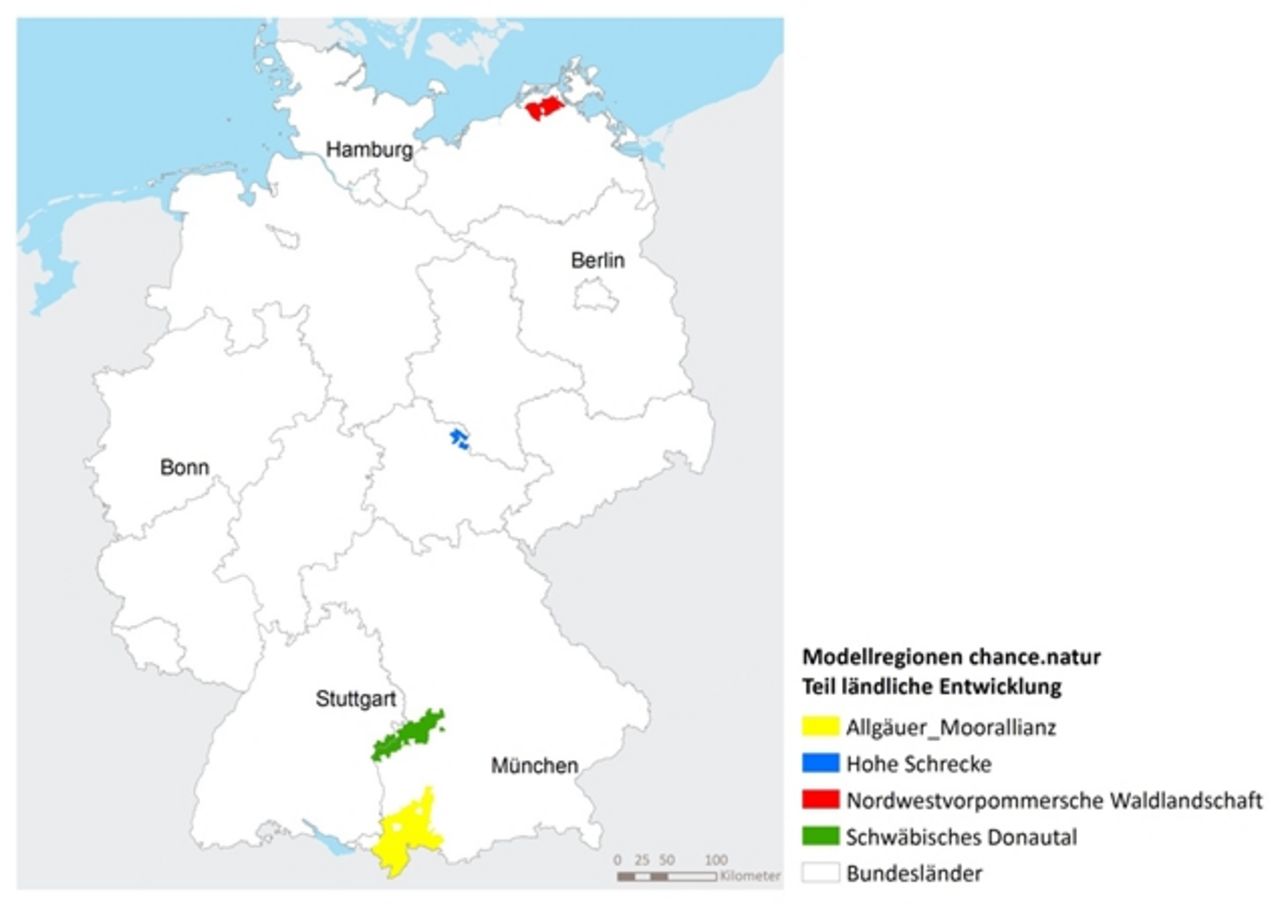Project
Concomitant research model-project chance.natur

The Model-project aims at joining Rural Development and Nature Conservation. What are the chances of linking Nature Conservation and Rural Development? What are the problems? This is the central question of the concomitant research on the model-project chance.natur
Background and Objective
chance.nature is a joint mocel-project of the Federal Ministry of Food and Agriculture (BMEL) and the Federal Ministry for the Environment, Nature Conservation, Building and Nuclear Safety ( BMUB) In the model-regions Nordvorpommersche Waldlandschaft (Mecklenburg-West Pomerania), Hohe Schrecke (Thuringia), Schwäbisches Donautal (Bavaria) und Allgäuer Moorallianz (Bavaria) subsedies from rural development and nature conservation are jointly used for the first time. The objectives of the project are:
- To identify synergies between nature conservation and rural development that may serve as examples for other regions,
- to establish value chains between nature conservation and rural development and
- to gain knowledge about the strength and weaknesses of integrating nature conservation and rural development.
The concomitant research analyses the benefit of the coupling of nature conservation with rural development.
Target Group
Federal Ministry of Food and Agriculture (BMEL)
Approach
We use qualitative and quantitative empirical methods such as meta-analysis, interview andsurvey. Thereby the analysis is grounded in the epistemological paradigm of "constructivism".
Our Research Questions
- How do actors and the integration of actors in networks and structures influence the success of the projects?
- What benefits has the coupling of different strands of subsedies?
Results
The evaluation shows that all regions succeeded in integrating the project in an existing overall regional development strategy as demanded by the program. This prevented the development of different independent strands of development strategies. In doing so it proved that the approach followed has the potential to complement already established development strategies and programs. One reason for this is, that the “Modellvorhaben chance.natur” allowed to support the acquisition of technical equipment like for example machines to ecologically-friendly cultivate litter meadows or special tractors to cultivate traditional orchards at hillside situations. Another reason is that the program allows to jointly support projects in between nature conservation and regional development. However, despite the joint approach the organization as well as execution of the model-program did not follow the manner of an integrated approach, but the particular already established logics of nature conservation and rural development respectively. Consequently this caused problems with regard to the coordination of nature conservation with rural development. As such, according to the evaluation, in the future it could be worth to consider the reasonability to apply already established program logics to new experimental approaches. Nevertheless the project clearly showed that the coupling of nature conservation with rural development induces quite a few, mainly positive, synergies such as: increasing the acceptance for nature conservation measures, the creation for new links in rural development by focusing on nature conservation, consolidation and promotion of the collaboration of different actors from nature conservation, rural development, tourism etc. These observations suggest that the coupling of nature conservation and rural development succeeded in inducing positive win-win-effects. The successful policy integration of nature conservation with rural development at the project level proved to be pivotal for these positive effects, although there could be identified room for improvement at the superordinate policy levels. The socioeconomic effects such as the creation of jobs or additional income possibilities or the generation of value added remained within the limits of that what can normally be achieved with rural development strategies. That means in all four model-regions it was possible to create job and income possibilities, to generate value added to stimulate regional processes and to lay the foundations for further development, but only in a limited way. This allows to conclude that the approach followed with the “Modellvorhaben chance.natur” represents a promising development strategy with room for improvement that should be further developed in the future taking into account the evaluation findings.
Thünen-Contact

Funding Body
-
Federal Ministry of Food und Agriculture (BMEL)
(national, öffentlich)
Duration
9.2014 - 2.2017
More Information
Project status:
finished
Publications to the project
- 0
Neumeier S (2018) "Modellvorhaben chance.natur" : Ergebnisse einer Begleitforschung zur Regionalentwicklung. Land Ber 21(2):45-64
- 1
Neumeier S (2017) Modellvorhaben chance.natur - ein Resümee der Begleitforschung "Regionalentwicklung". Ländl Raum (ASG) 68(4):21-25
- 2
Neumeier S (2017) Modellvorhaben chance.natur - Endbericht der Begleitforschung. Braunschweig: Johann Heinrich von Thünen-Institut, 368 p, Thünen Rep 51, DOI:10.3220/REP1505224575000

![[Translate to English:] [Translate to English:]](/media/_processed_/2/0/csm_LV_Bei_Hornburg_Quelle_Johanna_Fick_neu_da89674833.jpg)
![[Translate to English:] [Translate to English:]](/media/_processed_/2/0/csm_LV_Bei_Hornburg_Quelle_Johanna_Fick_neu_3aae309567.jpg)



